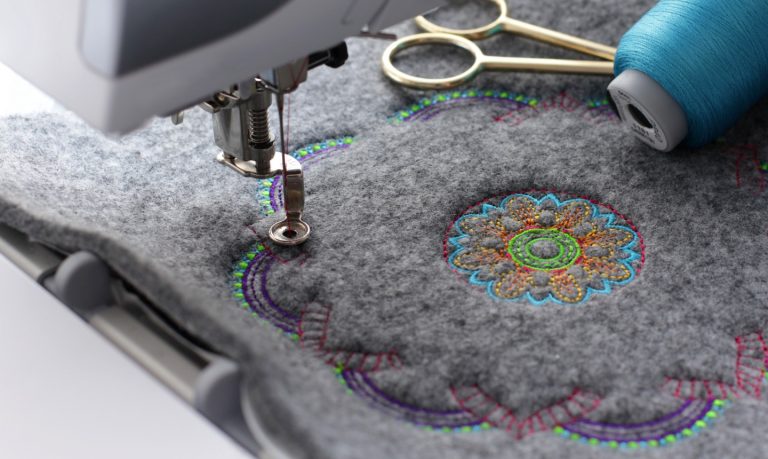Simplifying the Art of Needlework Digitizing: Step-by-Step Guide
As modern technology continues to advance, the digitization procedure has actually become extra available, allowing fanatics to bring their elaborate styles to life with ease. In this guide, we will certainly decipher the complexities of embroidery digitizing, damaging down each action carefully to streamline the process and empower both novices and experienced embroiderers alike.
Recognizing Embroidery Digitizing Software Program
Needlework digitizing software works as a crucial tool for changing elaborate styles right into digital styles compatible with needlework makers, facilitating accurate stitching and personalization. This specific software application enables users to import different photo documents formats, such as JPG or PNG, and transform them right into embroidery machine-readable styles like DST, EXP, or PES - Digitizing for Embroidery. By making use of attributes like stitch modifying, underlay alternatives, and thread shade option, digitizing software program makes it possible for customers to control every aspect of the layout process
Furthermore, advanced embroidery digitizing software supplies devices for developing complex designs, changing stitch thickness, and incorporating complex information. Individuals can likewise preview the design prior to sewing it out, ensuring precision and minimizing errors. Additionally, many software application programs provide automated attributes that help streamline the digitizing process, conserving time and initiative.
Understanding the abilities of needlework digitizing software application is vital for accomplishing high-quality lead to needlework jobs. By grasping this tool, embroidery enthusiasts and specialists can release their creativity and bring complex layouts to life with precision and effectiveness.

Selecting the Right Style Documents
After acquainting yourself with the abilities of embroidery digitizing software program, the following critical action in the procedure is choosing the right style declare your job. Digitizing for Embroidery. When picking a layout declare needlework digitizing, it's vital to consider the intricacy of the design, the size of the end product, and the kind of material you will certainly be collaborating with
For complex designs with great information, a high-resolution image or vector data is advised to make certain that the needlework maker can properly duplicate the design. In addition, the dimension of the last product plays a considerable function in choosing the best design data. Larger designs may call for higher resolution files to maintain clarity and sharpness.
Moreover, the sort of material you will certainly be embroidering on influences the choice of design documents. Various textiles might call for adjustments in the style documents to guarantee that the stitches are effectively lined up and the layout shows up as intended. By thoroughly picking the appropriate style documents based upon these elements, you can establish on your own up for a successful needlework digitizing procedure.
Digitizing Tools and Methods
Utilizing specialized software and accuracy methods, digitizing tools are necessary in transforming elaborate layouts right into embroidery-ready data. Embroidery digitizing software, such as Wilcom, Hatch, or Embrilliance, gives the Discover More necessary platform to convert art work right into stitch data. These programs supply attributes like stitch editing and enhancing, padding choices, and lettering devices to guarantee the design translates seamlessly onto material.
One of the vital strategies in digitizing is developing a clear course for the needlework machine to comply with. This entails digitizing each element of the layout with precision, establishing stitch types, thickness, and directions. By using tools like digitizing tablet computers or software-specific plugins, embroiderers can achieve a high degree of accuracy in their digitized styles.
Furthermore, mastering the art of rug stitching is critical for producing top quality embroidery. Underlay sewing supports the material and creates a foundation for the style, making certain that the end product is both visually appealing and resilient. By comprehending these digitizing devices and methods, embroiderers can elevate their craft and bring detailed layouts to life with accuracy and efficiency.
Customizing Stitch Types and Directions
Having actually established a structure in digitizing tools and techniques, an important facet ahead of time needlework craftsmanship depends on customizing stitch types and instructions with accuracy and purpose. The choice of stitch kinds can significantly affect the general look and appearance of the stitched style. Satin stitches, recognized for their smooth and glossy surface, work well for producing boundaries and message. On the various other hand, fill stitches are optimal for covering larger locations successfully. By strategically integrating these stitch types, embroiderers can accomplish deepness and measurement in their styles.
Moreover, the instructions of stitches plays an essential role in boosting the visual appeal of the last needlework. Diverse stitch instructions can add structure, emphasize particular great site elements, and create visual rate additional reading of interest. As an example, transforming the angle of stitches can simulate movement or all-natural patterns like hair or feathers. By explore various stitch angles and patterns, embroiderers can bring their styles to life with remarkable information and intricacy. Grasping the art of customizing stitch kinds and directions empowers embroiderers to unleash their creativity and raise the top quality of their job.
Screening and Refining Your Digitized Style
To ensure the precision and high quality of your digitized style, thorough testing and refinement are important steps in the embroidery digitizing process. As soon as you have finished the digitization of your design, it is critical to check it before waging the real embroidery. Testing allows you to determine any kind of potential concerns such as thread breaks, sew thickness troubles, or design distortions that might impact the outcome.

After testing, it is vital to improve your digitized style based upon the responses from the examination sew-out. This might entail tweaking stitch setups, changing densities, or making modifications to the total layout to accomplish the preferred outcome. By repeating through testing and improvement, you can adjust your digitized style to excellence prior to moving on with the real needlework process.
Verdict
In verdict, understanding the art of embroidery digitizing calls for an extensive understanding of the software program, selecting the appropriate style file, utilizing digitizing devices and strategies, tailoring stitch types and instructions, and testing and refining the digitized style. By adhering to these actions, embroiderers can streamline the digitizing procedure and produce high-grade stitched designs with precision and performance.